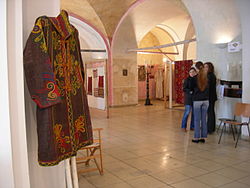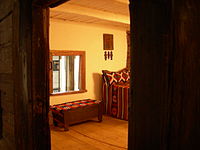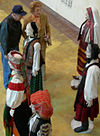| Revision as of 19:19, 21 August 2008 editBogdangiusca (talk | contribs)39,816 editsm Reverted edits by 89.122.229.4 (talk) to last version by Romanian bat← Previous edit | Revision as of 12:55, 23 September 2008 edit undoThe Anomebot2 (talk | contribs)Bots, Extended confirmed users1,043,658 edits Replacing geodata: {{coord|44|27|11.20|N|26|5|4.02|E|display=title}}Next edit → | ||
| Line 23: | Line 23: | ||
| * | * | ||
| {{ |
{{coord|44|27|11.20|N|26|5|4.02|E|display=title}} | ||
| {{Textile museums}} | {{Textile museums}} | ||
Revision as of 12:55, 23 September 2008
The Museum of the Romanian Peasant (Romanian: Muzeul Ţăranului Român) is a museum in Bucharest, Romania, with a collection of textiles (especially costumes), icons, ceramics, and other artifacts of Romanian peasant life. One of Europe's leading museums of popular arts and traditions, it was designated "European Museum of the Year" for 1996.
Located on Şoseaua Kiseleff, near Piaţa Victoriei, the museum falls under the patronage of the Romanian Ministry of Culture. Its collection includes over 100,000 objects.

First founded in the 1930s by and originally managed by Alexandru Tzigara-Samurcaş, the museum was reopened February 5, 1990, a mere six weeks after the downfall and execution of Nicolae Ceauşescu. During the Communist era, the building housed a museum representing the country's Communist party; the museum's basement still contains a room devoted to an ironic display of some artifacts from that earlier museum. The building, which uses traditional Romanian architectural features, was built on the former site of the State Mint (Monetăria Statului).
The museum was devastated during the June 1990 Mineriad, due to being confused with the headquarters of the National Peasants' Party.

One of the museum's most famous exhibits—originally the work of Tzigara-Samurcaş—is "the house in the house". The house, which originally belonged to peasant Antonie Mogos of Ceauru village in Gorj County. From the first, the house was displayed in a non-naturalistic way: objects that would normally be in the interior were displayed in various manners outside; outbuildings were suggested by fragments. The Communist regime displayed the house much more conventionally, outdoors at the Village Museum; it returned to the Peasant Museum in 2002. The current display at the Peasant Museum revives the original non-naturalistic approach. For example, from a platform, museum visitors may peer into the attic, part of whose wall is stripped away; various objects are arranged inside.
In 2002, the museum's exhibit space was greatly expanded as the museum store and offices moved into a new building behind the old one, freeing up a considerable amount of floor space in the museum proper.
Notes
- All awards 1977-2003, European Museum Forum. Accessed online 4 April 2007.
- "The house in the house", wall text, Museum of the Romanian Peasant.
External links
44°27′11.20″N 26°5′4.02″E / 44.4531111°N 26.0844500°E / 44.4531111; 26.0844500
Categories: